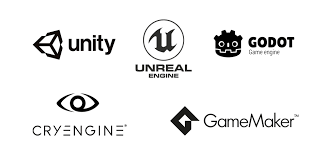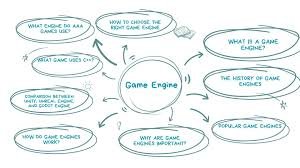A game engine is the invisible powerhouse behind every video game you play, from sprawling open-world adventures to simple mobile puzzles. Far more than just a piece of software, a game engine is a comprehensive set of tools and technologies that provides the fundamental framework for game developers to build, design, and run their creations. Think of it as a sophisticated operating system specifically designed for games, handling everything from stunning visuals and realistic physics to player interactions and artificial intelligence.
Understanding how game engines work doesn't require a deep dive into complex code; it's about appreciating the intricate dance of various components that come together to create the seamless, interactive experiences we love. These engines democratize game development, allowing creators to focus on creativity and storytelling rather than reinventing the wheel for every technical aspect. Whether it's the industry-leading Unreal Engine or the versatile Unity engine, or even a custom-built solution, every game relies on these powerful digital workshops.
The Brains Behind the Bytes: Why Game Engines Are Essential
Before game engines became widely available, developers had to build every single piece of technology from scratch for each new game. This was an incredibly time-consuming and costly process. Modern game engines provide:
- Efficiency: Reusable components and tools drastically speed up development.
- Cross-Platform Compatibility: Many engines allow games to be deployed on multiple platforms (PC, console, mobile) with minimal changes.
- Accessibility: User-friendly interfaces and scripting options (like visual scripting) empower a wider range of creators, not just expert programmers.
- Optimized Performance: Engines are built for speed and efficiency, ensuring smooth gameplay even with complex graphics and systems.
- Unified Workflow: They integrate various aspects of game creation – art, sound, coding, level design – into a single environment.
Deconstructing the Digital World: Core Components of a Game Engine
A game engine's architecture is a symphony of specialized systems, each responsible for a crucial aspect of the game.
1. The Rendering Engine (Graphics): Bringing Worlds to Life
This is arguably the most visually impressive part of a game engine. The rendering engine, or graphics engine, is responsible for drawing everything you see on screen. It takes 3D models (characters, environments, objects), textures, lighting information, and camera viewpoints, and transforms them into the 2D images displayed on your monitor or screen.
- How it works simply: Imagine a painter trying to represent a 3D scene on a flat canvas. The rendering engine is like that painter, but with a super-fast computer. It uses techniques like:
- Vertex Processing: Taking the geometric points (vertices) that define a 3D model and translating them into positions on the screen.
- Rasterization: Converting those geometric shapes into a grid of pixels.
- Fragment Processing (Pixel Shading): For each pixel, determining its final color based on textures, lighting, shadows, and material properties.
- Optimization: Employing techniques like “culling” (not rendering objects outside the camera's view) and “Level of Detail” (LOD) to reduce complexity for distant objects, ensuring smooth real-time rendering and high frame rates.
- Keywords: rendering engine, graphics engine, 3D graphics, 2D rendering, real-time rendering, shaders, textures, lighting, frame rates.
2. The Physics Engine: Simulating Reality
The physics engine is what makes objects in a game behave realistically, from a bouncing ball to a car crashing into a wall. It simulates natural phenomena like gravity, friction, momentum, and collisions.
- How it works simply: When you jump in a game, the physics engine calculates your trajectory based on gravity. When two objects hit, it determines if they collide (collision detection) and how they react (collision response) – do they bounce, shatter, or slide? Most engines use simplified physics models that are computationally efficient enough for games, focusing on believable rather than perfectly accurate simulations.
- Keywords: physics engine, collision detection, collision response, gravity, friction, realistic physics, game simulation.
3. The Audio Engine (Sound): Creating Immersive Soundscapes
A great game isn't just about what you see; it's also about what you hear. The audio engine manages all sound effects, music, and dialogue within the game world.
- How it works simply: It handles playing sounds, adjusting their volume based on distance (attenuation), spatializing them (making them sound like they come from a specific direction, known as 3D audio), and even applying effects like reverb or occlusion (muffling sounds behind objects). Modern audio engines can dynamically adjust music and sound effects based on gameplay events, enhancing immersion.
- Keywords: audio engine, sound effects, game music, 3D audio, spatial audio, sound design.
4. Input System: Listening to the Player
This component is the game's ears and hands, processing all input from the player's devices.
- How it works simply: Whether it's a keyboard press, a mouse click, a joystick movement, or a touchscreen swipe, the input system receives these signals. It then translates these device-specific inputs into generalized game actions (e.g., “move forward,” “jump,” “shoot”), which the game logic can understand and react to. This abstraction allows developers to support various control schemes without rewriting core game code.
- Keywords: game input, user input, input processing, control schemes, keyboard input, mouse input, game controller.
5. Scripting & AI Systems: Defining Behavior and Intelligence
These systems give life to characters and objects, dictating how they behave and react.
- Scripting: Game engines often include scripting languages (like C#, Python, or visual scripting tools like Unreal Engine's Blueprint) that allow designers and programmers to define game logic, character behavior, and interactive elements without directly touching the engine's core code. This makes iterating on gameplay faster and easier.
- Artificial Intelligence (AI): The AI system governs the behavior of non-player characters (NPCs).20 This can range from simple patrol patterns to complex decision-making, pathfinding (how NPCs navigate the environment), and reacting to player actions. Modern AI in games uses techniques like finite state machines, behavior trees, and even machine learning to create believable and challenging opponents or allies.
- Keywords: game scripting, AI in games, game logic, NPC behavior, pathfinding, visual scripting, game development tools.
6. Asset Management & Resource Loading: Organizing the Chaos
Games are built from thousands of assets: 3D models, textures, sound files, animations, and more. The asset management system organizes all these files.
- How it works simply: It ensures that when the game needs a particular model or sound, it can quickly find, load, and manage it in memory. This is crucial for performance, especially in large open-world games where assets are constantly being streamed in and out as the player moves.
- Keywords: asset management, game resources, resource loading, memory management, game assets.
The Game Loop: The Heartbeat of the Engine
Underneath all these systems lies the game loop, the engine's constant rhythm.
- How it works simply: It's a continuous cycle that runs many times per second (e.g., 60 times for a 60 FPS game). In each cycle, the engine:
- Processes Input: Checks for player actions.
- Updates Game State: Calculates physics, AI decisions, animations, and other game logic.
- Renders Frame: Draws the current state of the game world to the screen.This loop is what gives games the illusion of continuous motion and interactivity.
- Keywords: game loop, game development cycle, frame per second (FPS), real-time interaction.
Popular Game Engines: The Industry Giants
While many proprietary engines exist, two names dominate the commercial landscape:
- Unity Engine: Known for its versatility and ease of use, Unity is a favorite for indie developers, mobile games, and even AAA titles. Its strong community and asset store make it highly accessible.
- Unreal Engine (Epic Games): Renowned for its cutting-edge graphics and powerful tools, Unreal Engine is a powerhouse for high-fidelity AAA games, cinematic experiences, and virtual production. Its Blueprint visual scripting system is a standout feature.
- Keywords: Unity engine, Unreal Engine, game development software, game creator tools, Epic Games.
Conclusion: The Unsung Heroes of Interactive Entertainment
Game engines are the unsung heroes of the interactive entertainment world. They are complex feats of engineering that abstract away the daunting technical challenges, allowing developers to channel their creativity into crafting compelling narratives, challenging gameplay, and breathtaking virtual worlds. By understanding these fundamental components, you gain a deeper appreciation for the intricate artistry and technological prowess that goes into every single game you play. The next time you pick up a controller or tap your screen, remember the sophisticated engine quietly working beneath the surface, bringing digital dreams to life.










